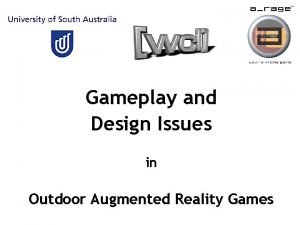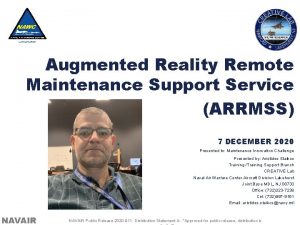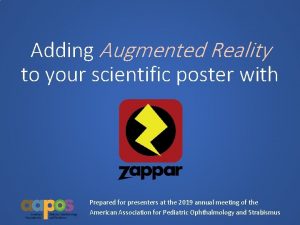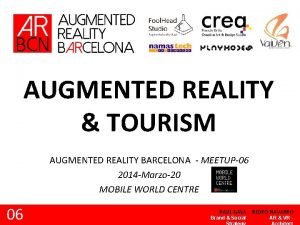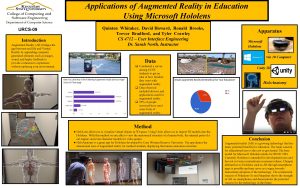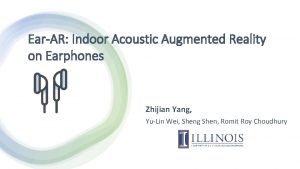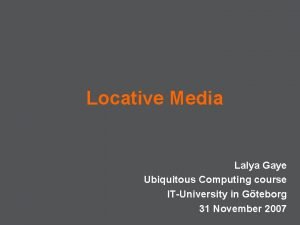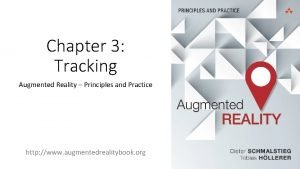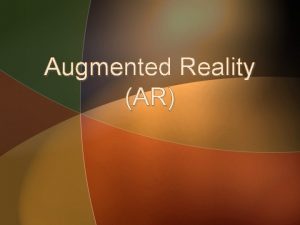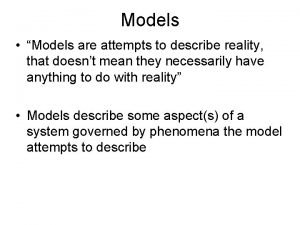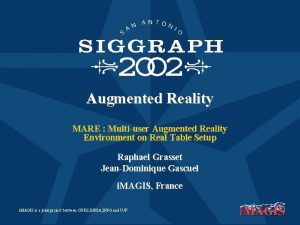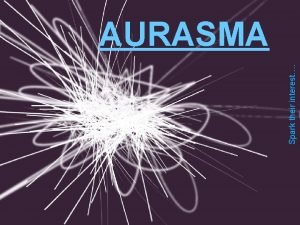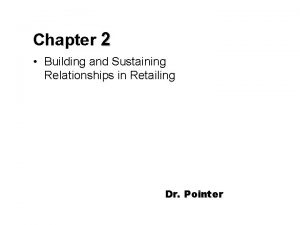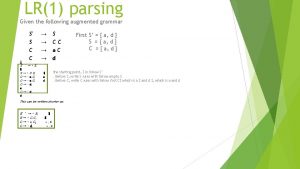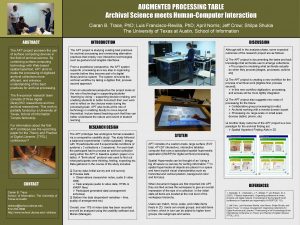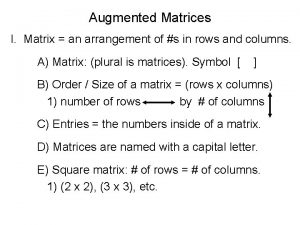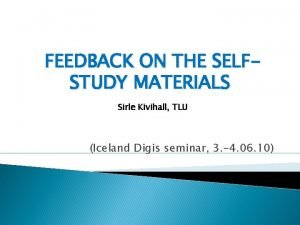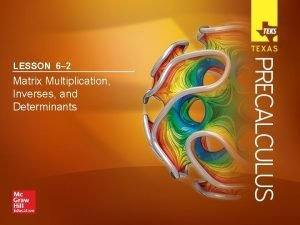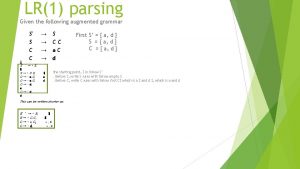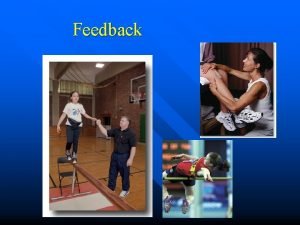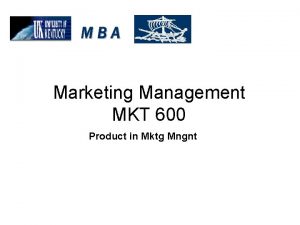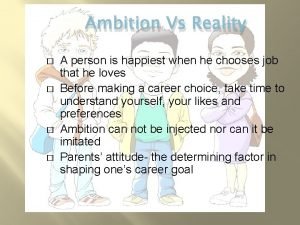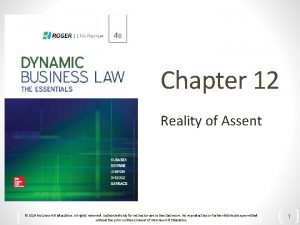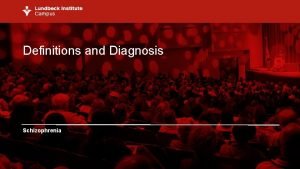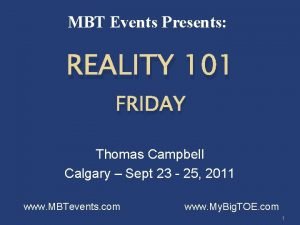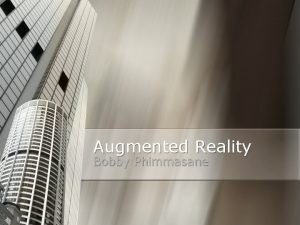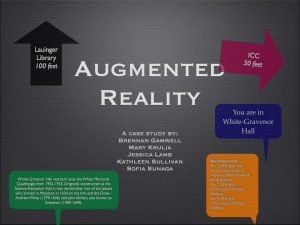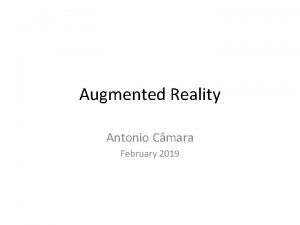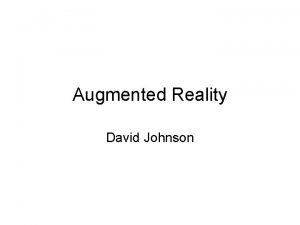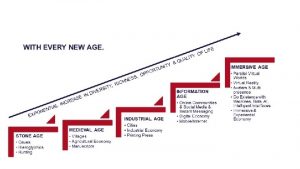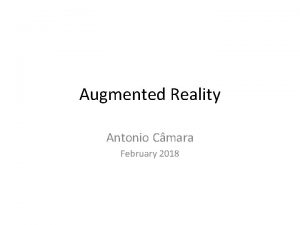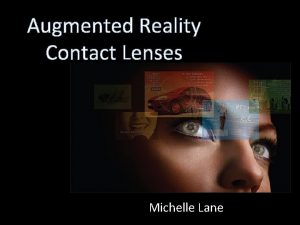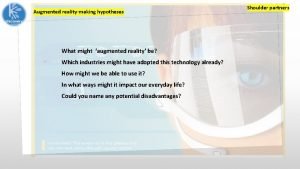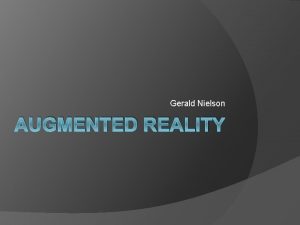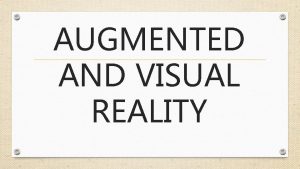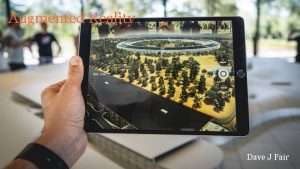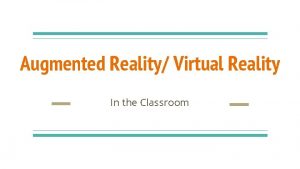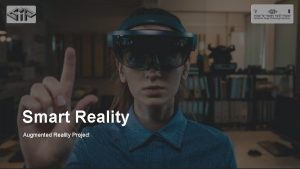AUGMENTED REALITY AUGMENTED REALITY AUGMENTED REALITY AUGMENTED REALITY
















































- Slides: 48

AUGMENTED REALITY

AUGMENTED REALITY

AUGMENTED REALITY

AUGMENTED REALITY

AUGMENTED REALITY

AUGMENTED REALITY Case Study

AUGMENTED REALITY

AUGMENTED REALITY

AUGMENTED REALITY

AUGMENTED REALITY

AUGMENTED REALITY

AUGMENTED REALITY

AUGMENTED REALITY

AUGMENTED REALITY

AUGMENTED REALITY

AUGMENTED REALITY CASE STUDY ä Exposure treatment: One hour. ä The patient interacted with the cockroach in the container, and also with the cockroach outside the container. ä The patient killed four cockraches.

AUGMENTED REALITY ä Treatment outcomes were maintained at one-month follow-up. ä Reports of high Reality judgment and Presence.

AUGMENTED REALITY Case Series Study Participants: 10 patients so far (9 women and 1 man) ä Four with spider phobia ä Six with cockroach phobia Treatment: Adaptation of the one-session exposure program developed by Öst delivered with Augmented Reality.

AUGMENTED REALITY Results: BAT (0 -12) PATIENTS 1 2 3 BASELINE 5 6 6 PRE-TEST 5 6 6 POST-TEST 12 12 12 4 5 6 7 8 9 10 7 5 0 0 5 0 5 12 12

AUGMENTED REALITY Results: Self-report (0 -126) PATIENTS 1 2 3 PRE-TEST 114 91 95 POST-TEST 19 68 40 4 5 6 7 8 9 10 60 111 95 95 71 95 121 35 86 45 48 34 39 43

AUGMENTED REALITY Preference: IN VIVO vs AR (0 -7) PATIENTS 1 2 3 4 5 6 7 8 9 10 Willingness of getting involved in a treatment with AR exposure 7 4 7 7 6 7 7 7 Willingness of getting involved in a treatment with in vivo exposure 6 4 4 5 4 2 4 4 5 5

AUGMENTED REALITY Satisfaction (0 -10) PATIENTS 1 2 3 Do you think the procedure is logic? 9 9 10 10 Your level of satisfaction with the procedure 10 9 9 8 8 8 10 10 Would you recommended it to a friend? 10 9 9 10 10 10 Do you think it could be useful for treating other psychological problems? 10 9 10 10 8 10 10 10 Do you find the treatment aversive? 2 7 0 7 Do you think the treatment 10 7 has been useful in treating your problem? 4 5 6 7 8 9 1 5 7 1 7 9 10 7 7 7 9 10 10

AUGMENTED REALITY Conclusions ä AR: Efficacious in the treatment of specific phobia. ä Significant reduction in objective and subjective measures of fear and avoidance. ä Patients preferred AR rather than in vivo exposure. ä Patients were satisfied with the treatment.

Controlled Studies: n > 8 Fear of Driving Author Country Year # of Pts Tx Grps Berger Kim U. S. Korea 1999 16 9 PC VR, Phobics, Non-Phobics PC VR, WLC Wiederhold Jang U. S. Korea 2001 2002 9 11 VR, In vivo Driving vs. Flying Walshe Ireland 2003 14 ECT, CBT, WLC

Ø Types of VR equipment used clinically: Regular Desktop Multiple Screens Head Mounted Display Full Car Automobile Seat

Driving Study: 9 participants (Wiederhold BK, Jang DP, Kim SI, Wiederhold MD, 2001) Treatment Success Specific Phobia PDA PTSD

Fear of Driving Movie Clip

Social Phobia Patient wearing a HMD while engaging in the virtual party

Controlled Studies: n > 8 Social Phobia Author Country Year # of Pts Tx Grps Slater Lègeron Roy U. K. France 2003 10 36 10 Neutral, demanding VR, CBT, WLC Klinger France 2005 36 VR, CBT

Social Phobia (Klinger, Bouchard et al. , 2004) N = 36, 12 sessions. CBT in group.

SOCIAL PHOBIA (Klinger et al. , 2005) • Sample Population = 18 participants – 10 females and 8 males – Mean age: 30. 5 ± 5. 06 – On average, participants have been suffering from social phobia for 14. 5 years – 9 participants were also displayed symptoms of major depression (all information based only on the VRT group)

SOCIAL PHOBIA (Klinger et al. , 2005) • Measures – The Short Beck Depression Inventory (BDI-13) – The Liebowitz Social Anxiety Scale (LSAS) – The Rathus Assertiveness Schedule – The Zigmond and Snaith Hospital Anxiety Depression Scale (HAD)

SOCIAL PHOBIA (Klinger et al. , 2005) • Protocol – for VRT only – Overview • 12 sessions of VRT • 45 minutes each • Exposed to virtual environments for either assessment or therapy • Virtual exposure lasts less than 20 minutes per session

SOCIAL PHOBIA (Klinger et al. , 2005) • Protocol (cont’d) – Virtual environments included 4 situations that social phobic patients felt were the most threatening: • • Performance Intimacy Scrutiny Assertiveness

SOCIAL PHOBIA (Klinger et al. , 2005) • Protocol (cont’d) – Session 1 • Therapist presents virtual world to patient • Patient familiarizes the virtual world and tools in a neutral environment – Session 2 -9 • 2 sessions devoted to each of the 4 virtual environments – Assessment, expose patient to VR environment, 2 phases of “therapy” exposure to the environment

SOCIAL PHOBIA (Klinger et al. , 2005) • Protocol (cont’d) – Session 10 -12 • 3 sessions devoted to more focused and detailed work on one or two of the four environments that gave the patient the most trouble • 12 th session = conclusion to therapy and introduction of a personal program to carry out beyond therapy

SOCIAL PHOBIA (Klinger et al. , 2005)

SOCIAL PHOBIA (Klinger et al. , 2005) • Conclusion: – Based on the LSAS, VRT would illustrate a better form of treatment over CBT – The differences between the two groups, however, are not significant – For VRT to be significantly better than CBT in terms of social phobia symptoms, experiment participants would have to be increased to 200 -300 – Participants should be increased to a sample of 3, 000 in order to find a significant difference in performance anxiety – In order to further confirm the efficacy of virtual reality for the treatment of social phobia, additional outcome studies could be conducted with the inclusion of a third control condition such as a placebo or a waiting list

Social Phobia Movie Clip

Internet-based Worlds

SOCIAL PHOBIA Online Worlds to Help with Social Phobia www. there. com www. secondlife. com

Human Avatars

Animal Avatars

Controlled Studies: n > 8 Panic Disorder with Agoraphobia Author North Kim Botella Wiederhold Botella Country U. S. Korea Spain U. S. Spain Year # of Pts 1998 30 1999 9 2002 10 2002 9 2003 36 Tx Grps PC VR, WLC PC VR, In vivo Non-phobics in PDA environ. VRE, In vivo, WLC Multi-center Controlled Study Riva Wiederhold Bouchard Italy U. S. Canada 2002 45 45 45 PC VR, In vivo, WLC Kim Korea 2002 45 PC VR, In vivo, WLC

Agoraphobia: 12 participants (Vincelli, Anolli, Bouchard, Wiederhold, Zurloni, & Riva, 2003) Patient Treatment Ø Ø Ø VR-CBT WLC Design Ø Ø VR-CBT 8 sessions CBT 12 sessions Results Ø VR-CBT produced same or better results using 33% fewer sessions than CBT Measures Ø Ø Beck Depression Inventory State Trait Anxiety Inventory Agoraphobic Cognitions Questionnaire Fear Questionnaire

Agoraphobia: 12 participants (Vincelli, Anolli, Bouchard, Wiederhold, Zurloni, & Riva, 2003)

“The Mall”

“The Room”
 Ufofps
Ufofps Augmented reality landscaping app
Augmented reality landscaping app Augmented reality remote maintenance
Augmented reality remote maintenance Create augmented reality poster
Create augmented reality poster What is augmented reality
What is augmented reality Microsoft augmented reality for students
Microsoft augmented reality for students Ricky tsui
Ricky tsui Ear-ar: indoor acoustic augmented reality on earphones
Ear-ar: indoor acoustic augmented reality on earphones Augmented reality architecture diagram
Augmented reality architecture diagram Augmented reality user experience
Augmented reality user experience What is augmented reality
What is augmented reality Augmented reality: principles and practice
Augmented reality: principles and practice Augmented reality big data
Augmented reality big data Bayer augmented reality
Bayer augmented reality Ciri ciri augmented reality
Ciri ciri augmented reality Ionic augmented reality
Ionic augmented reality Multi user augmented reality
Multi user augmented reality Studio aurasma
Studio aurasma Augmented reality business cards
Augmented reality business cards Augmented reality final year projects
Augmented reality final year projects Augmented reality card game
Augmented reality card game Building and sustaining relationships in retailing
Building and sustaining relationships in retailing Augmented feedback meaning
Augmented feedback meaning Augmented data structure examples
Augmented data structure examples Augmented transition network in nlp
Augmented transition network in nlp Augmented grammar
Augmented grammar Augmented processing table
Augmented processing table How to solve augmented matrix on ti-84
How to solve augmented matrix on ti-84 Solve system of linear equations calculator
Solve system of linear equations calculator Augmented dsml
Augmented dsml Augmented feedback
Augmented feedback Defibrillator circuit diagram
Defibrillator circuit diagram 6 by 6 matrix example
6 by 6 matrix example Augmented grammar in artificial intelligence
Augmented grammar in artificial intelligence Lr1 parsing
Lr1 parsing Product differentiation
Product differentiation Actual product adalah
Actual product adalah Benign definition in the giver
Benign definition in the giver Inverse of a 3×3 matrix
Inverse of a 3×3 matrix Task intrinsic feedback
Task intrinsic feedback Augmented vector left
Augmented vector left Mkt 600
Mkt 600 Ambition vs reality
Ambition vs reality 4 paths to salvation hinduism
4 paths to salvation hinduism Who made this statement
Who made this statement Ivan sutherland head mounted display
Ivan sutherland head mounted display Dsm 5 vs dsm 4
Dsm 5 vs dsm 4 Sherlock holmes reality
Sherlock holmes reality Tom campbell virtual reality
Tom campbell virtual reality
